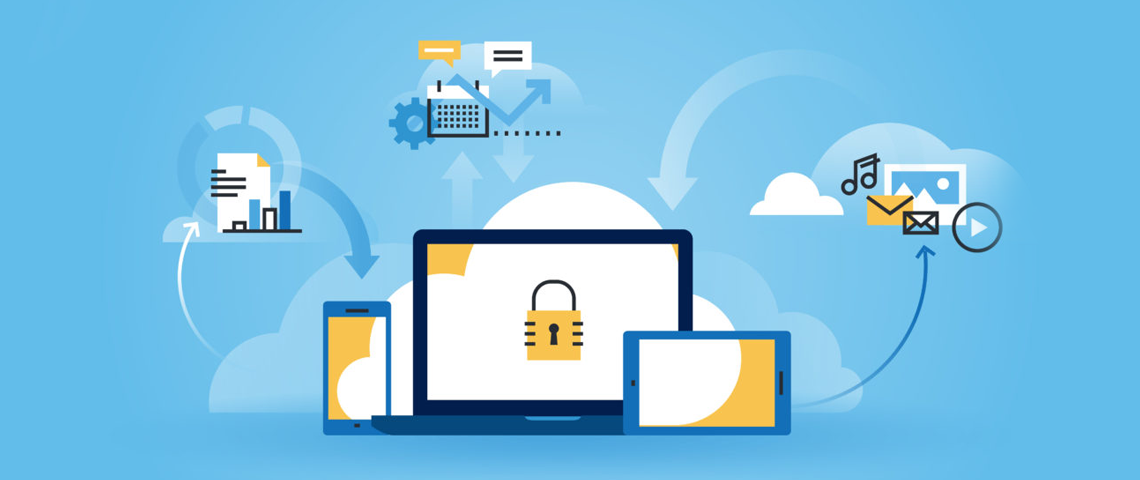The Enterprise Cloud Platform


Cloud computing has many advantages, but it comes with its own set of challenges. Security is one of the most critical challenges but can be dealt with effectively. Encryption, virtual data centers, virtual LANs and other similar measures can be taken to deliver cloud applications securely even in shared and multi-tenant environments.
Businesses are doing whatever they can to increase IT response times and reduce costs. Therefore, many of them are moving their applications to the cloud. As long as you choose a reputed provider, they will implement the same security measures as your internal IT team, but even today, some businesses are still skeptical.
However, truth be told, cloud service providers can sometimes offer you greater security than your internal IT team. Security may be a challenge, but there are so many effective ways to address it.
The only thing required of you – partner up with the right cloud provider because that really matters a lot.
Security in the cloud environment is essential for businesses to compete and meet consumer demands. Security levels can be matched to those offered by onsite solutions if proper investments are made in terms of efforts and time. Trustful applications can be deployed which would isolate data of every company even if the environment is shared or comprises of multiple tenants. If encryption, virtual data centers, and virtual LAN technologies are leveraged, the offered security can even exceed the service levels of your in-house IT team. Your cloud provider also complies with stringent regulations, so their solutions can offer the maximum security possible.
Cloud technologies may be adopted in a private, public or hybrid environment. And the services can be delivered as SaaS, IaaS or PaaS. The security requirements are unique and must be addressed in a tailored sort of way, considering the overall cloud solution that is being deployed.

What kind of cloud security concerns exists?
If you are thinking of moving a critical application to the cloud, security would be a concerning factor. In a traditional IT environment, security is easier to manage. Techniques such as authentication, authorization, access control and encryption can be used to ensure a highly secure environment. Whatever controls are put in place, there are laws accompanied by a comprehensive IT security policy and properly written procedures. Employees are informed and trained, and together, all of them manage security cohesively.
Even in a typical environment, some of the users, like clients and vendors, do fall outside of your control but they also access your organization network. However, techniques allow you to limit this access and gain complete visibility over their activities. Through simple procedures, you can decide which of your users can access a particular dataset or can perform a certain action.
The data that is stored outside the organizational network is exposed to some risks. Third party services may bypass security controls that your IT department has over in-house IT systems. Laws do allow the end users to specify where the data to be stored and processes. In general, if you do want to make changes, you would have to under the processes and systems of your provider. So for public, shared and multitenant environments, you should trust your provider and leave it to them to guard their data for you. But providers do limit liabilities for security lapses at times, which possess additional concerns.
Governing and monitoring applications and resources the cloud can indeed, be a challenge. To deal with the issue effectively, here is what you should address.
- Your data should be protected and remain completely confidential when you are moving it to the cloud over an internet connection.
- You’ll have to comply with legal and regulatory compliance.
- You have to trust the processes and team of your cloud provider as you hand over your data to them.
- Steps must be taken to ensure that your data doesn’t mingle with data from other users in the environment.
What security requirements should be addressed?
A secure cloud environment is not enough. Security should be robust and trustful while giving you ample control to manage and monitor your applications. Here are the most prevalent security requirements which you must address in an enterprise cloud environment.
Robust Security
Robust security implies a layered model instead of the typical perimeter-based approach toward security. This ensures that data is properly isolated even if the environment is shared among multiple tenants. Robust security is achievable by introducing content protection mechanisms at different layers such as the storage layer, virtual machine, and the database. The implemented mechanisms must cater to confidentiality and provide access control. Encryption, key management, log management and auditing can all be utilized in this aspect.
Trust and Assurance
Trust can be achieved when you have confidence in the cloud environment integrity and can depend on the physical data centers, hardware, software, processes and the people. Your cloud provider should develop trust by offering reporting capabilities and application monitoring and control. Transparency must exist between your provider and you, especially where vulnerabilities are involved. Audit trails, automated notifications, alerts configuration, incident management and other similar should be offered so that you manage security by yourself.
Solutions that are based on these features also ascertain quality and reliability of the chosen cloud provider, allowing you to play an active role in managing and governing your cloud applications.
Monitoring and Governance
Cloud governance refers to utilities that let you monitor security, ensure compliance and ascertain that various KPIs (for performance or reliability) are being met. You should be able to use the tools provided exactly as if the cloud application was in your organizational environment, and should be able to perform similar tasks and activities.
Moreover, the offered tools should allow you take necessary action depending on the security information that you should automatically receive from your service provider. Common actions include shutting or disabling an application if it’s under attack. You may also have to compel the provider to tighten security procedures, especially if patches or updates aren’t being carried out in a timely manner.
Governance also takes into account risk management; this allows you to customize your costs for threat impacts that are most probable as well as for ones that have a lower chance of being met. Your providers should also address issues related to legal compliance, reimbursement, and other things.

Which security controls should you put in place?
Your cloud security provider will manage security and take steps to keep your data safe. However, there are several things that you can do on your part to protect your critical applications and virtual machines. Providers offer you a wide range of tools and services for security purposes, but you’ll probably have to implement various defensive mechanisms. Just like your cloud provider you’re also responsible for protecting your data, users, and networks.
Misconfiguration can lead to problems
Cloud isn’t insecure, but problems arise when the applications and networks aren’t configured for security. Amazon Web Services run in a highly secure environment, but when you are adopting these platforms, you also have to configure them correctly. And for this, you should fully understand the process. Here are some of the essential security measures that any cloud application should have.
Understand your responsibilities
Cloud services differ from each other and so what you may be responsible for varies with your chosen model and plan. For instance, if you opt for a SaaS provider, they would make sure that the application is completely protected and data is stored and transmitted in a secure manner. But on the other hand, if you go with something such as the Amazon EBS or the AWS Elastic Compute Cloud, you would be responsible for managing OS configuration, application management, and data protection. Should you choose something like Simple Storage Service or S2, you’d be responsible for data management, access control, and identity policies. You do get tools for data encryption, but still, you are responsible for protecting the entry points of your network. Amazon does, however, take the responsibility of application and OS management for S3.
So check with your chosen cloud provider and understand who is responsible and for what.
Control access
A research estimated that more than 30% of databases in the open cloud environment can be accessed over the internet and another 93% don’t put any restrictions on outbound traffic. 9% of workloads also accept traffic from simply any IP address regardless of the port, whereas only the bastion hosts and the load balance should have internet access.
Don’t enable internet access if there isn’t a need. Also, don’t enable global permissions for any of your servers; administrators often make the mistake of doing this by using 0.0.0.0/0 in subnets that are public. Leaving SSH open is another common mistake; should you do this, you are actually allowing anyone to bypass the network firewall and gain direct access to the data if they know where the server is located that is.
Generally, cloud providers give you access to various identity management and access control tools, so make sure are utilizing them. You should know who can access your data and when, and you should also know who can access how much data. When you create identity policies and develop access control levels, provide limited privileges required for a particular task or role. Additional permissions should be granted temporarily whenever required. Set up your security groups such that the focus in the narrowest, and use a reference is for each of these groups when you can.
Protect your data
The next step is to protect your data using appropriate mechanisms. Control your encryption network whenever you can. Generally, you assign your cloud vendor the responsibility for providing key access, but generally, you should do what you can to protect your data. Cloud providers do a good job, but it’s your data, so you should have control over all encryption keys.
That being said, remember one thing, you’re making a whole lot of difference if you use strong encryption mechanisms. They are mostly failsafe so even if your data is accessed by an unauthorized individual, they still wouldn’t be able to read it.
Secure credentials
Access keys can be exposed to source code repositories and public websites. However, they are one of the most sensitive pieces. Educate your team and employees to never, ever, leak these keys in any public space.
You should create unique keys for all external services while restricting access wherever and to whomever, you can. None of the keys should have broad permissions; this prevents them from being used to access sensitive data if they fall into the wrong hands.
Also, rotate the keys after 90 days at the most on a regular basis. If you delay this, you may be giving hackers sufficient time to intercept the keys and enter your environment.
In addition, make sure that you don’t use the root user account, even if you want to perform an administrative task. Instead, assign all the required privileges to a new user, and then use that user for all administrative work. As for the root account, you should lock it down, enable multi-factor authentication and limits it uses to only specific tasks.
Lastly, disable all user accounts that aren’t being used.

What other measures can you implement?
In-depth defense is important in a cloud environment. Even if one of the controls would fail, there would still be others that would ensure the security of your data, application, and network. Also enable multi-factor authentication because it increases security, and makes it harder for potential intruders to break into.
Enable logs and monitor them continuously for potential issues and unauthorized access attempts.
Still think securing cloud will be a challenge? Get in touch with us and we’ll put in all necessary measures for a safe and secure cloud environment.
Build your ideal
software today

